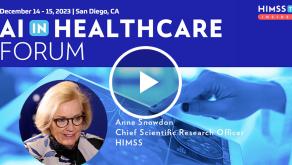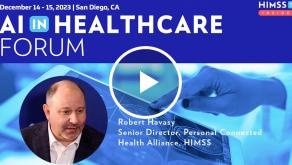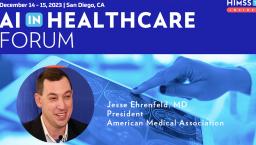2024 outlook: AI focus will shift to specialized machine learning that addresses specific business problems

Maxime Vermeir, senior director of AI strategy at ABBYY
Photo: Maxime Vermeir
2024 will see a boom in artificial intelligence in healthcare that will lead to a greater scrutiny of AI's various processes. The AI boom will result in a skills gap and a need for more specialist IT training. And while the use of AI in healthcare grows, it won't be generative AI like ChatGPT.
These are predictions for next year from Maxime Vermeir, senior director of AI strategy at ABBYY, an intelligent automation company. With a decade of experience in product and technology, Vermeir works to drive higher customer value with emerging technologies across various industries, including healthcare.
His artificial intelligence expertise helps enable powerful business systems and transformation initiatives through large language models and other advanced applications of AI. His mission is to help client organizations achieve their digital transformation goals and unlock new opportunities with AI.
Healthcare IT News spoke with Vermeir, asking him to explain his predictions in-depth and offer healthcare provider organization CIOs, fellow C-suite executives and health IT leaders guidance on AI for the year ahead.
Q. You suggest AI will grow – but not generative AI like ChatGPT. What kind of AI will grow and where? And why won't generative AI grow?
A. Using generative AI today to search and summarize data consumes 10 times the energy of a normal search – it’s simply unsustainable and is not relevant for most business cases. Regulatory scrutiny is also likely to intensify to ensure the safe and ethical use of AI in healthcare.
This could encompass rigorous validation of AI solutions like ChatGPT models to ensure accuracy, transparency in AI decision-making and adherence to patient data privacy laws.
In healthcare, the focus will shift from general AI to more specialized, contextual AI and machine learning systems that address specific business problems effectively.
Specialized AI systems can be developed to address precise medical challenges such as disease diagnosis, treatment planning and patient management. Unlike general AI, these specialized solutions can be tailored to adhere to medical protocols, understand medical billing and codes, understand healthcare regulations, and ensure patient safety, making them more suitable for healthcare applications.
Healthcare IT leaders will discover they can solve many of their business challenges using purpose-built applications – 90% of it originating from needing access to, and human-like understanding of, their own data and processes.
Purpose-built AI can ease administrative burden and accelerate patient care such as fast-tracking referrals to see specialists or getting approval for life-saving medications. For example, only 54% of faxed referrals result in an appointment – leading to patient leakage, care delays and overall health outcomes degradation.
By applying AI technologies to the referral process, providers can automatically identify and extract handwritten and text notes containing referral reasons, and prioritize urgent referrals with all the strict data protection and auditability required in healthcare.
A recent Chime-Cerner survey indicated nearly 40% of provider participants are losing at least 10% of patient revenue to referral leakage. And non-processed referrals cost hospitals between $821,000 to $971,000 per physician per year.
Q. You say artificial intelligence will result in a skills gap and a need for more specialist IT training. Please elaborate.
A. Recent nationwide strikes by healthcare professionals have amplified workers' need for better work-life balance. That’s why more AI will be used to augment staff with their administrative duties ranging from appointment schedulers to emergency room staff to physicians.
AI will help healthcare workers understand patients’ records and recommend and process authorization forms and claims 50% faster.
However, while frontline workers represent over 70% of the U.S. workforce, a recent study showed only 14% say they have received training on how AI will affect their jobs. In fact, one of the main reasons for automation projects failing is due to lack of staff training, according to a survey commissioned by ABBYY.
Healthcare leaders must take the initiative and ensure staff are properly trained. As we anticipate the integration of AI in healthcare, it's important to draw lessons from historical trends in technology adoption. The digital divide, a term used to describe the gap between demographics with easy access to digital technology and those without, offers valuable insights into potential disparities in AI adoption in healthcare.
Recent statistics underscore this divide. According to Pew Research Center, the shares of Americans in each income tier who have home broadband or a smartphone have not significantly changed from 2019 to 2021. This indicates a persistent gap in technology access among different income groups, which could translate into varied levels of AI adoption within the healthcare workforce.
Additionally, rural adults are less likely than their urban and suburban counterparts to have home broadband and less likely to own digital devices like smartphones, tablets or computers. This rural-urban divide could potentially mirror in healthcare settings, affecting both healthcare providers and patients in different geographic areas.
The historical adoption trends of the internet and e-commerce demonstrate that while new technologies eventually become widespread, the pace and extent of adoption can vary greatly across different demographics.
This suggests that as AI becomes more prevalent in healthcare, there will be varying levels of readiness and capability to utilize these technologies effectively. This underscores the importance of targeted training and education programs to ensure equitable access to AI tools and their benefits.
To ensure no demographic is left behind in this technological shift, healthcare leaders must prioritize upskilling and reskilling initiatives. These should be designed to cater to diverse learning needs and backgrounds, ensuring that all healthcare professionals, regardless of their starting point, can effectively leverage AI in their roles.
Moreover, it's crucial to consider the end users of healthcare services, who may also face barriers in accessing and benefiting from AI-driven healthcare due to the digital divide.
So, while AI offers transformative potential in healthcare, its equitable adoption and beneficial impact across all demographics hinge on proactive and inclusive training strategies. These strategies should be informed by an understanding of existing disparities in technology access and usage, as highlighted by the digital divide phenomenon.
As a result, training and retraining will be a major priority in healthcare in 2024 and beyond to ensure employees are up to speed. There are plenty of workshops, webinars and open-source tools available as well as more intense offerings from the likes of Coursera, Udemy and edX covering relevant topics such as machine learning, deep learning and AI applications.
Healthcare IT leaders must also ensure that vendors deploying their automation are providing the right skills training.
Q. You predict there will be a boom in AI in healthcare that will lead to greater scrutiny of processes. What do you mean by this? What will this mean for health IT leaders at provider organizations?
A. The sudden growth of generative AI reignited calls for stricter regulations, with President Joe Biden recently signing a sweeping new executive order to place guardrails on the use and development of AI, such as making large AI models like OpenAI’s GPT-5 subject to review before they are released.
The executive order also will take steps to begin establishing new standards for AI safety and security, and shield Americans’ privacy and civil rights.
This will trigger advancements in explainable AI (XAI). XAI could become pivotal in healthcare to provide clear explanations of AI-driven diagnoses and treatment recommendations. This transparency can help build trust among healthcare providers and patients, ensuring that AI acts as a support tool rather than an opaque decision-maker.
As a result, healthcare organizations will need to understand exactly how their information and data is processed, especially with the massive growth of digital transformation, as many healthcare companies are now citing AI investment as a main target over the next few years.
This growth in automation will mean current processes being scrutinized, not only for efficiency and success, but for compliance reasons. However, this analysis of processes will need to be achieved effectively, especially with new research showing up to 70% of automation projects fail.
Relying on employee feedback to drive change can lead to incorrect or biased information, which can result in the wrong processes being automated. Healthcare organizations will need to establish a data-driven, decision-making process for their automation project by implementing analytics technology to gather deep insights and inform strategic choices.
The rise of such analytics tools, driven by artificial intelligence and machine learning, enables businesses to understand their own processes and operations more thoroughly – before moving forward with change.
One such technology is process intelligence, which combines task mining and process mining to depict an accurate and detailed model of a workflow in real time to better identify opportunities for automation. In addition, with the strict data protection and auditability required in healthcare, IT leaders can use the technology to ensure compliance, through setting preset business rules that highlight any potential violations, helping organizations maintain legal standards.
In fact, IDC has affirmed the growing use of this type of process mining technology in digital transformation, and states that it was the highest growing subset of the intelligent process automation market, with a 2022-2026 CAGR of 50.5% and revenues reaching $3 billion in 2026.
Follow Bill's HIT coverage on LinkedIn: Bill Siwicki
Email him: bsiwicki@himss.org
Healthcare IT News is a HIMSS Media publication.
























